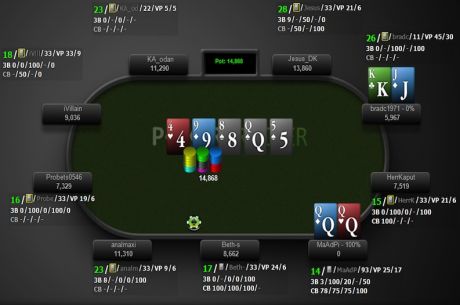Teachable Moments From Twitch: Ryan Laplante on Reliable HUD Stats

If you did not catch World Series of Poker bracelet winner Ryan Laplante's 11 days of Twitch streaming at the end of September, then you missed a treat.
Laplante's stream was special because he thoroughly explained every decision he made in order to show how he plays both a highly exploitive style against recreational players and a well balanced GTO style against the best regs. This was such a treat for those of us looking to get better, because he came in seeking to educate more so than to entertain like most streamers.
Fortunately for those of you who missed it, he saved the videos for viewing on demand at his Twitch channel. I am carefully going through every second of these streams in order to find all the hidden strategy gems and bring some of them to you over the coming weeks. The first lesson that stood out was when he explained his minimalist HUD (Heads-Up Display).
Laplante only uses five statistics on his HUD. These include��
- VPIP - How often a player voluntarily puts money into the pot
- PFR - How often a player raises preflop
- RFI - How often a player raises first into a pot as the preflop opener
- 3-Bet - How often a player three-bets a raise preflop
- STL - How often a player attempts to steal the blinds from late position
Using only five stats may be somewhat surprising in an age where we have access to so much information. However, Laplante makes a compelling case for why he goes this route.
As Laplante explains, he uses this basic HUD setup because these are the stats that converge into a reliable sample size over the shortest period of time. Given that these are all preflop stats, you have an opportunity for new data points in almost every orbit you play.
This is not true of postflop stats like continuation betting ("c-bet") which tells you how often the preflop aggressor makes a continuation bet postflop. In order to get a new entry for that stat, the player must raise preflop, not get three-bet, and then not get led into on the flop. Unlike the opportunity to voluntarily put money into the pot preflop, this combination of events does not present itself very often.
To prove this point, Laplante showed stats for a player on which he had 300 hands. This sounds like a decent sample size, and it is for preflop stats. However, when he showed the postflop pop-up, we saw that this player only had 11 opportunities to c-bet in the 300 hands they had played together.
This is not a big enough sample size to read much into a c-bet statistic that at first glance may look too low or too high. This is especially true when you consider that the stat does not account for differences in position, stack size, board texture, or number of players who saw the flop. The numbers get even less reliable when you start looking at turn and river stats.
Postflop data simply does not converge fast enough to be as useful as preflop data. For this reason, Laplante believes that they should be viewed in the pop-up when the sample become reliable and not in the onscreen HUD. And when you do view these postflop stats, instead of looking at the number of hands played, you must look at the number of opportunities presented in order to ensure a decent sample size before making use of postflop data.
Laplante says that many regs and recreational players make mistakes by reading too much into small postflop sample sizes. I will try to remember this lesson and keep it in mind the next time I am tempted to make a play based on postflop HUD stats.
In this Series
- 1 Teachable Moments From Twitch: Capping Ranges With Small Bet Sizing
- 2 Teachable Moments From Twitch: Chance Kornuth on Preserving Tournament Equity
- 3 Teachable Moments From Twitch: Ryan Laplante on Reliable HUD Stats
- 4 Teachable Moments From Twitch: Leading Into the Preflop Raiser
- 5 Teachable Moments From Twitch: Triple-Barrel Bluffing With 'bencb789'









